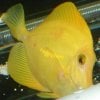A picture is worth 1000 words so here we have a collection of pictures of fish with diseases.
Pictures here are largely posted and contributed by members of this forum. Contributions from fellow hobbyists will go towards helping other aquarists who can not post pictures or identify the ailment of their sick fish. If anyone prefers not to have their fish's picture posted here, please just let me know through this site's private messaging system.
Thank you for your contribution to this hobby!
Quick Clicks below:
Aggression
Bacterial Infections
Black Ich
Brooklynella
Goiter: Sharks and Stingrays
Head and Lateral Line Erosion (HLLE)
Hyper-Melaninization
Ich-Cryptocaryon irritans
Lymphocystis
Pop-Eye Infection
Stress
Pictures here are largely posted and contributed by members of this forum. Contributions from fellow hobbyists will go towards helping other aquarists who can not post pictures or identify the ailment of their sick fish. If anyone prefers not to have their fish's picture posted here, please just let me know through this site's private messaging system.
Thank you for your contribution to this hobby!
Quick Clicks below:
Aggression
Bacterial Infections
Black Ich
Brooklynella
Goiter: Sharks and Stingrays
Head and Lateral Line Erosion (HLLE)
Hyper-Melaninization
Ich-Cryptocaryon irritans
Lymphocystis
Pop-Eye Infection
Stress
Last edited:

















































































